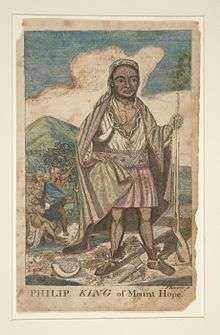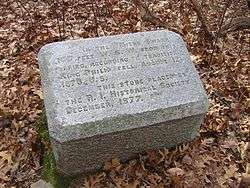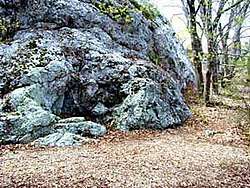Metacomet
Metacom (1638 – August 12, 1676), also known as Metacomet and by his adopted English name King Philip,[1] was sachem (elected chief) to the Wampanoag people and the second son of the sachem Massasoit. Metacom became sachem in 1662 when his brother Wamsutta (or King Alexander) died shortly after the death of their father. Wamsutta's widow Weetamoo (d. August 6, 1676), squa sachem (a female chief) of the Pocasset, was Metacom's ally and friend for the rest of his life. Metacom married Weetamoo's younger sister Wootonekanuske. It is unclear as to how many children they had or what happened to them. Wootonekanuske and one of their sons were sold to slavery in the West Indies following the defeat of the Native Americans in what became known as King Philip's War.
Metacom | |
|---|---|
 | |
| Wampanoag Sachem | |
| Preceded by | Wamsutta |
| Personal details | |
| Born | 1638 |
| Died | August 12, 1676 (aged 37–38) Bristol, Rhode Island |
| Cause of death | Assassinated |
Initially, Metacom sought to live in harmony with the colonists. As a sachem, he took the lead in much of his tribes' trade with the colonies. He adopted the European name of Philip, and bought his clothes in Boston, Massachusetts.
The colonies continued to expand. To the west, the Iroquois Confederation also was fighting against neighboring tribes in the Beaver Wars, pushing them from the west and encroaching on Metacom's territory. Finally, in 1671, the colonial leaders of the Plymouth Colony forced major concessions from him. Metacom surrendered much of his tribe's armament and ammunition, and agreed that they were subject to English law. The encroachment continued until hostilities broke out in 1675. Metacom led the opponents of the English, with the goal of stopping Puritan expansion.
Name change
In the spring of 1660 Metacom's brother Wamsutta appeared before the court of Plymouth to request that he and his brother be given English names in accordance with Wampanoag custom, in which new names marked significant moments in time (such as, in this case, Wamsutta's father's death). The court agreed and Wamsutta had his name changed to Alexander, and Metacom's was changed to Philip. Author Nathaniel Philbrick has suggested that the Wampanoag may have taken action at the urging of Wamsutta's interpreter, the Christian neophyte John Sassamon.[2] Metacom was later called "King Philip" by the English.
King Philip's War
King Philip used tribal alliances to coordinate efforts to push European colonists out of New England. Many of the native tribes in the region wanted to push out the colonists following conflicts over land use, diminished game as a consequence of expanding European settlement, and other tensions.
As the colonists brought their growing numbers to bear, King Philip and some of his followers took refuge in the great Assowamset Swamp in southern Massachusetts. He held out for a time, with his family and remaining followers.
Hunted by a group of rangers led by Captain Benjamin Church, King Philip was fatally shot by a praying Indian named John Alderman, on August 12, 1676, in the Misery Swamp near Mount Hope in Bristol, Rhode Island. After his death, his wife and nine-year-old son were captured and sold as slaves in Bermuda. Philip's head was mounted on a pike at the entrance to Plymouth, Massachusetts, where it remained for more than two decades. His body was cut into quarters and hung in trees.[3] Alderman was given Philip's right hand as a trophy.
Representations
- Mary Rowlandson, who was taken captive during a raid on Lancaster, Massachusetts, later wrote a memoir about her captivity, and described meeting with Metacom while she was held by his followers.
- Washington Irving relates a romanticized but sympathetic version of Metacom's life in the 1820 sketch "Philip of Pokanoket," published in his collected stories, The Sketch Book of Geoffrey Crayon, Gent. (1820).
- John Augustus Stone wrote the play, Metamora; or, The Last of the Wampanoags (1829) for the notable actor Edwin Forrest as lead.
- In his short story "The Devil and Daniel Webster" (1937), Stephen Vincent Benet portrays Metacom as a villain to the colonists, and as being killed by a blow to the head (he was shot in the heart). Webster is portrayed as respecting Metacom as one of those who "formed American history." Metacomet, together with other famous historical villains, takes Webster's side against the Devil. In the film he is replaced by Asa, the Black Monk.
- Metacom is featured in the 1995 film The Scarlet Letter as the Wampanoag's new chief after his father's death.
- David Kerr Chivers' Metacomet's War (2008) is an historical novel about King Philip's War.
- Narragansett journalist John Christian Hopkins's novel, Carlomagno, is a historical novel that imagines Metacom's son becoming a pirate after having been sold into slavery in the West Indies.
- The novel "My Father's Kingdom" (2017, by James W. George) focuses on the events leading to King Philip's War.
Legacy


Numerous places are named after Metacomet:
- Metacomet Mill in Fall River, Massachusetts, built in 1847 and named for the chief, is the oldest remaining textile mill in the city.
- King Philip Stockade, a large park named after the chief, where the Pocumtuc Indians planned and began the Sack of Springfield, is now a part of Forest Park in Springfield
- King Philip Mills in Fall River, Massachusetts, built 1871
- The USS Metacomet, an 1863 United States Navy ship
- The Metacomet Ridge, a 100-mile long mountain range in southern New England
- The 51-mile Metacomet Trail in central Connecticut
- The 110-mile Metacomet-Monadnock Trail in the Connecticut River Valley of Massachusetts and southern New Hampshire
- Metacomet Country Club, a golf course in East Providence, Rhode Island
- Metacomet Park in Medfield, Massachusetts
- The Metacomet parcel of conservation land within the Black Brook Management Area in Easton, Massachusetts
- Metacom Avenue, a major road running through Bristol and Warren, Rhode Island
- Metacomet Avenues in Ocean Grove and South Deerfield, Massachusetts
- Metacomet Lane in Franklin, Massachusetts
- Metacomet Road in Longmeadow, Massachusetts
- Metacomet Streets in Wrentham, Walpole, and Belchertown, Massachusetts
- Multiple Metacomet street names surrounding the Metacomet Trail in Connecticut
- Mettacomet Path, a street in Harvard, Massachusetts
- Metacomet Drive (improperly designated by the USPS as Metacomet Street) in San Antonio, Texas [4]
- Metacomet Lake, a point of interest in Belchertown, Massachusetts
- King Philip Street in Fall River, Massachusetts
- King Philip Regional High School, serving Plainville, Wrentham, and Norfolk, Massachusetts
- King Philip Regional Middle School in Norfolk, Massachusetts, which serves as the middle school for the above three towns
- King Philip Middle School in West Hartford, Connecticut
- King Phillip's Cave in Norton, Massachusetts, a cave said to have been used by the chief as a hiding place towards the end of his reign[5]
- King Philip Mountain, a peak on Talcott Mountain, near Hartford, Connecticut
- King Philip's Hill, on the western bank of the Connecticut River in Northfield, Massachusetts
- King Phillip's Nose, a rock island in the Connecticut River, south of Northfield, Massachusetts
- King Philip's Rock, a historic site situated on a trail in Sharon, Massachusetts
- King Philip's Restaurant in Phillipston, Massachusetts
- King Philip Avenue/Road/Street or Drive in East Providence and Bristol, Rhode Island; Fall River, Longmeadow, Raynham, Somerset, Worcester, and South Deerfield, Massachusetts; and in West Hartford, Connecticut
- King Philip Woods Conservation Land in Sudbury, Massachusetts[6]
- King Philip, the clipper ship built in 1856, is periodically seen at Ocean Beach in San Francisco, California
- Phillips Pond and Phillipswood Road in Sandown, New Hampshire
One insect species is named after Metacomet:
- Tipula metacomet, a species of large crane fly with a type locality in Amherst, Massachusetts
See also
- Rev William Apess, claimed descent from Metacomet
- List of early settlers of Rhode Island
Footnotes
- Lepore, Jill. The Name of War: King Philip's War and the Origins of American Identity, New York: Alfred A. Knopf, 1998. Note: King Philip "was also known as Metacom, or Metacomet. King Philip may well have been a name that he adopted, as it was common for Natives to take other names. King Philip had on several occasions signed as such and has been referred to by other natives by that name."
- Philbrick, p. 196
- "Blood and Betrayal: King Philip's War", History Net
- Plat filed in the real property records of Bexar County, Texas at Vol. 5870, P. 88
- History: MGA Links at Mamantapett, MGA Links (archived 2006)
- https://sudbury.ma.us/locations/kingphilip/ Retrieved 2018-10-11
References
- Bourne, Russel (1990). The Red King's Rebellion. ISBN 0-689-12000-1.
- Philbrick, Nathaniel, Mayflower: A Story of Courage, Community, and War. New York: Viking Penguin. ISBN 0670037605.
External links
| Wikimedia Commons has media related to Metacomet. |
- The Royal Gazette article: The struggle to honour Bermuda’s Native American heritage.
- Rootsweb: New England Indians. Bermuda Reconnection Festival 2002 Photo Album.
- Rootsweb: Edward Randolph on the Causes of the King Philip's War (1685).
- Rootsweb: St. David's (Bermuda) Indian Committee.
- Pokanoket/Wampanoag Constitution. With History.
- US History.com: King Philip's War, 1675–76.
- . Appletons' Cyclopædia of American Biography. 1900.
- King Philip's Biography